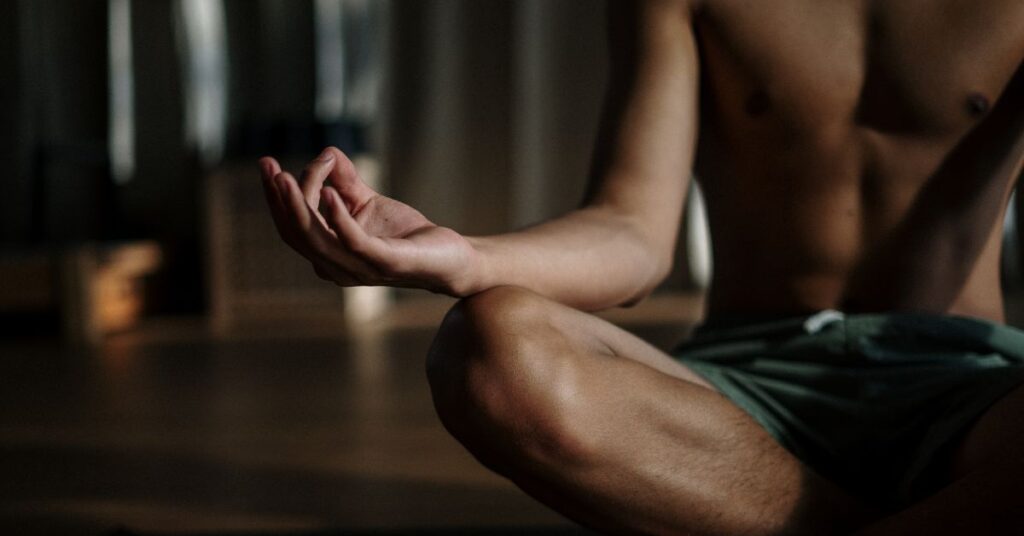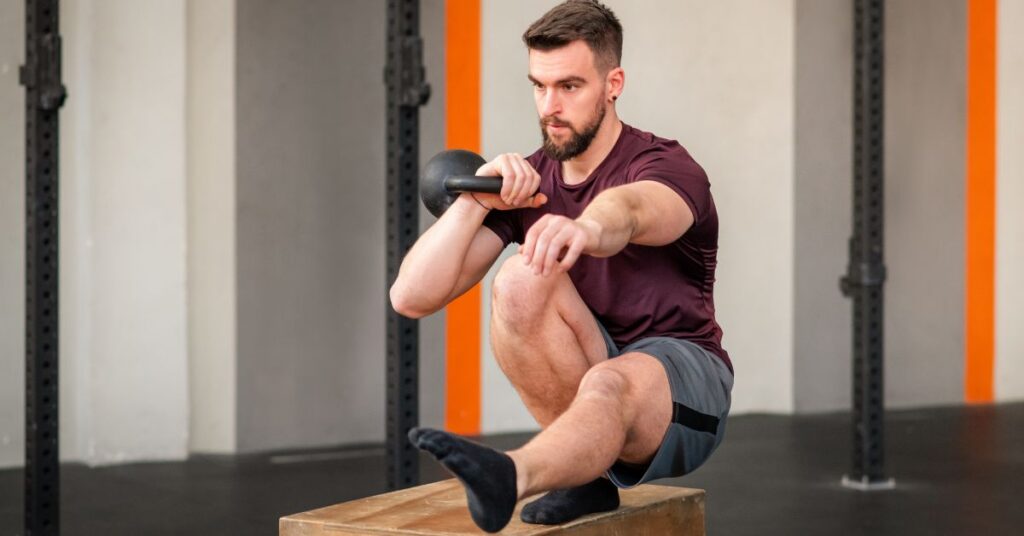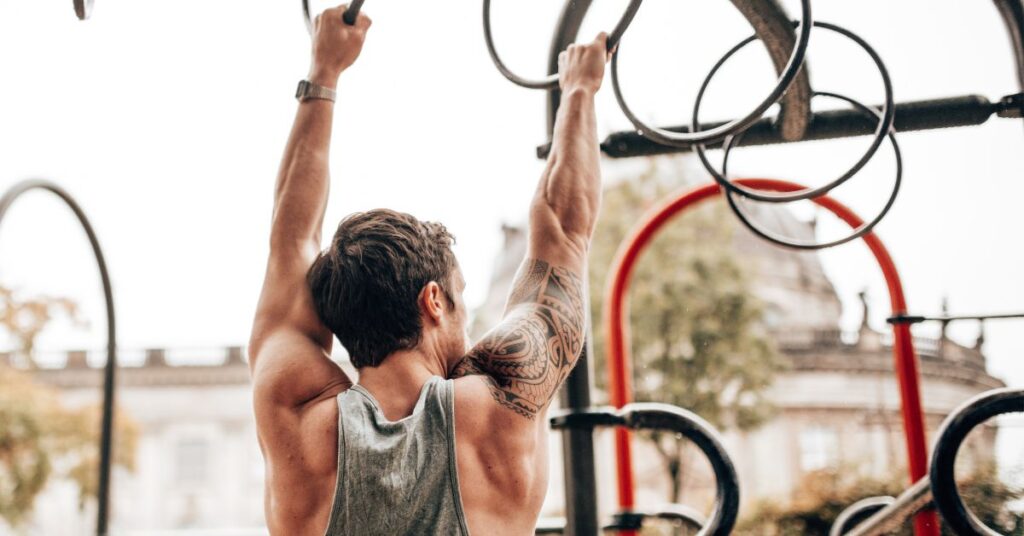20 Essential Calisthenics Leg Exercises are: Squats, Lunges, Single-Leg Squats, Calf Raises, Jump Squats, Step-Ups, Wall Sits, Glute Bridges, Bulgarian Split Squats, Goblet Squat, Cossack Squats, Plyometric Lunges, Nordic Curls, Reverse Lunges, Single-Leg Glute Bridge, Single-Leg Deadlift, Curtsy Lunges, Pistol Squats, Jump Rope, Lateral Step-Ups.
Learning calisthenics leg exercises transforms your lower body strength using only bodyweight movements that build functional power and muscular endurance. Understanding calisthenics leg exercises helps you develop strong, defined legs without requiring expensive equipment or gym memberships for effective training.
Table of Contents
20 Important Calisthenics Leg Exercises
Mastering calisthenics leg exercises requires understanding the fundamental movements that target all major muscle groups in your lower body. This comprehensive breakdown reveals the most effective bodyweight leg exercises for building strength, endurance, and functional movement patterns.
| Sr.No | Exercise | Primary Muscles | Difficulty Level | Benefits |
| 1 | Squats | Quadriceps, glutes, hamstrings | Beginner | Foundation movement |
| 2 | Lunges | Quadriceps, glutes, calves | Beginner | Unilateral strength |
| 3 | Single-Leg Squats | Quadriceps, glutes, core | Advanced | Balance and strength |
| 4 | Calf Raises | Calves, stabilizers | Beginner | Lower leg strength |
| 5 | Jump Squats | Full legs, power | Intermediate | Explosive power |
| 6 | Step-Ups | Quadriceps, glutes | Intermediate | Functional movement |
| 7 | Wall Sits | Quadriceps, glutes | Intermediate | Isometric strength |
| 8 | Glute Bridges | Glutes, hamstrings | Beginner | Posterior chain |
| 9 | Bulgarian Split Squats | Quadriceps, glutes, stabilizers | Intermediate | Unilateral power |
| 10 | Goblet Squat | Quadriceps, glutes, core | Beginner | Core engagement |
| 11 | Cossack Squats | Adductors, glutes, mobility | Intermediate | Lateral strength |
| 12 | Plyometric Lunges | Full legs, explosiveness | Advanced | Athletic power |
| 13 | Nordic Curls | Hamstrings, posterior chain | Advanced | Eccentric strength |
| 14 | Reverse Lunges | Quadriceps, glutes, balance | Beginner | Knee-friendly |
| 15 | Single-Leg Glute Bridge | Glutes, hamstrings, core | Intermediate | Hip stability |
| 16 | Single-Leg Deadlift | Hamstrings, glutes, balance | Intermediate | Posterior strength |
| 17 | Curtsy Lunges | Glutes, inner thighs | Intermediate | Multi-planar movement |
| 18 | Pistol Squats | Full legs, balance | Advanced | Ultimate unilateral |
| 19 | Jump Rope | Calves, coordination | Beginner | Cardio conditioning |
| 20 | Lateral Step-Ups | Glutes, outer thighs | Intermediate | Frontal plane strength |
1. Squats
Squats form the foundation of calisthenics leg exercises, targeting your quadriceps, glutes, and hamstrings while building functional strength for daily activities. This fundamental movement teaches proper hip and knee mechanics essential for all lower body training.
2. Lunges
Lunges are versatile calisthenics leg exercises that develop unilateral strength and improve balance while targeting major leg muscles. This movement pattern enhances coordination and addresses muscle imbalances between your left and right legs.
3. Single-Leg Squats
Single-leg squats represent advanced calisthenics leg exercises that challenge strength, balance, and coordination simultaneously. This unilateral movement builds exceptional lower body strength while improving ankle stability and core engagement.
4. Calf Raises
Calf raises are essential calisthenics leg exercises that target your lower leg muscles, improving ankle strength and stability. This movement enhances athletic performance and prevents common lower leg injuries through targeted muscle development.
5. Jump Squats
Jump squats add explosive power to your calisthenics leg exercises routine, developing fast-twitch muscle fibers and athletic performance. This plyometric movement combines strength training with cardiovascular conditioning for comprehensive fitness benefits.
6. Step-Ups
Step-ups are functional calisthenics leg exercises that mimic real-world movements like climbing stairs or stepping onto elevated surfaces. This exercise develops unilateral strength while improving coordination and balance.
7. Wall Sits
Wall sits are isometric calisthenics leg exercises that build muscular endurance and mental toughness through sustained muscle contractions. This challenging exercise strengthens your quadriceps and glutes while improving lower body stability.
8. Glute Bridges
Glute bridges are crucial calisthenics leg exercises that target your posterior chain, strengthening glutes and hamstrings while improving hip mobility. This movement counteracts the effects of prolonged sitting and enhances athletic performance.
9. Bulgarian Split Squats
Bulgarian split squats are elevated calisthenics leg exercises that intensify unilateral training through rear-foot elevation. This challenging movement develops exceptional single-leg strength while improving hip flexor flexibility and ankle mobility.
10. Goblet Squat
Goblet squats are beginner-friendly calisthenics leg exercises that emphasize core engagement and proper squat mechanics. This variation helps maintain upright posture while building foundational strength in the quadriceps and glutes.
11. Cossack Squats
Cossack squats are lateral calisthenics leg exercises that develop frontal plane strength and hip mobility. This unique movement pattern targets the adductors while improving ankle and hip flexibility essential for athletic performance.
12. Plyometric Lunges
Plyometric lunges are explosive calisthenics leg exercises that develop rapid force production and athletic power. This advanced movement combines strength training with jump training to enhance sports performance and lower body explosiveness.
13. Nordic Curls
Nordic curls are advanced calisthenics leg exercises that provide intense eccentric hamstring strengthening. This challenging movement builds exceptional posterior chain strength while improving knee stability and injury prevention.
14. Reverse Lunges
Reverse lunges are knee-friendly calisthenics leg exercises that reduce forward knee stress while maintaining strength benefits. This backward stepping pattern is ideal for beginners or those with knee sensitivities.
15. Single-Leg Glute Bridge
Single-leg glute bridges are intermediate calisthenics leg exercises that isolate each glute while challenging core stability. This unilateral movement addresses imbalances and builds hip strength essential for athletic performance.
16. Single-Leg Deadlift
Single-leg deadlifts are balance-challenging calisthenics leg exercises that strengthen the posterior chain while improving proprioception. This functional movement enhances coordination and builds strength in the hamstrings and glutes.
17. Curtsy Lunges
Curtsy lunges are multi-directional calisthenics leg exercises that target the glutes from unique angles. This cross-body movement pattern strengthens the outer hip muscles while improving hip mobility and stability.
18. Pistol Squats
Pistol squats represent the pinnacle of calisthenics leg exercises, requiring exceptional strength, balance, and mobility. This advanced single-leg squat variation builds ultimate unilateral strength while challenging every aspect of lower body fitness.
19. Jump Rope
Jump rope is a rhythmic calisthenics leg exercise that combines cardiovascular conditioning with calf strengthening. This time-efficient movement improves coordination, agility, and lower leg endurance while providing excellent calorie burning.
20. Lateral Step-Ups
Lateral step-ups are frontal plane calisthenics leg exercises that strengthen the often-neglected outer hip muscles. This side-stepping movement improves lateral stability and addresses common imbalances caused by forward-dominant training patterns.
Discover key tips and techniques in How to Lift Heavier Weights and start making serious gains.
What are Calisthenics Leg Exercises?
Calisthenics leg exercises are bodyweight movements that use your own body weight as resistance to build lower body strength, endurance, and mobility. These exercises require no equipment and can be performed anywhere, making them perfect for home workouts and travel fitness routines.
Understanding bodyweight exercises for beginners provides foundation knowledge for incorporating calisthenics leg exercises into comprehensive fitness programs.
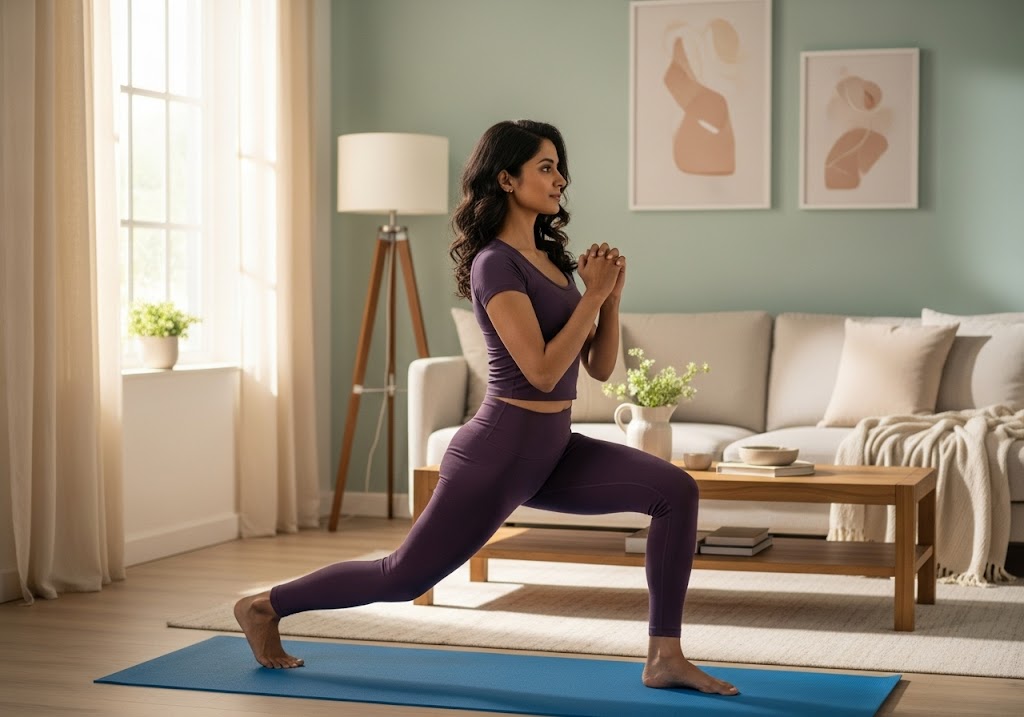
Learn What Is Foam Rolling and how it boosts recovery, flexibility, and performance.
Types of Calisthenics Leg Exercises
Exploring different categories of calisthenics leg exercises helps you create balanced training programs that target all muscle groups and movement patterns. Each type serves specific purposes in developing comprehensive lower body strength and functionality.
| Exercise Type | Examples | Primary Focus | Training Benefits |
| Bilateral Squats | Bodyweight squats, jump squats | Both legs together | Foundation strength |
| Unilateral Movements | Lunges, single-leg squats | One leg at a time | Balance and stability |
| Plyometric Exercises | Jump squats, jump lunges | Explosive power | Athletic performance |
| Isometric Holds | Wall sits, single-leg holds | Static strength | Endurance building |
| Posterior Chain | Glute bridges, single-leg bridges | Back leg muscles | Hip strength |
| Calf Exercises | Calf raises, single-leg raises | Lower leg muscles | Ankle stability |
| Dynamic Movements | Step-ups, lateral lunges | Multi-directional | Functional strength |
| Core Integration | Overhead squats, jump squats | Full body | Stability training |
Benefits of Calisthenics Leg Exercises
Understanding the benefits of calisthenics leg exercises motivates consistent training while revealing why bodyweight leg exercises are essential for comprehensive fitness development. These advantages extend beyond simple muscle building to include functional strength and athletic performance improvements.
- Functional Strength Development: Calisthenics leg exercises build strength that directly translates to daily activities like climbing stairs, lifting objects, and maintaining balance during dynamic movements throughout your everyday life.
- Improved Balance and Stability: Regular practice of calisthenics leg exercises enhances proprioception and balance through unilateral movements and challenging positions that require core engagement and coordination.
- Enhanced Athletic Performance: These bodyweight leg exercises develop power, speed, and agility essential for sports performance while improving movement efficiency and reducing injury risk during athletic activities.
- Cardiovascular Benefits: Many calisthenics leg exercises elevate heart rate and provide cardiovascular conditioning while building muscular strength, creating efficient workouts that improve overall fitness levels.
- No Equipment Required: The convenience of calisthenics leg exercises allows for consistent training regardless of location or access to gym facilities, making fitness accessible and sustainable.
- Progressive Difficulty: From beginner-friendly squats to advanced single-leg movements, calisthenics leg exercises offer natural progression paths that challenge you throughout your fitness journey.
- Joint Health and Mobility: These exercises promote healthy joint movement patterns and improve flexibility through full range of motion movements that maintain and enhance lower body mobility.
- Core Strengthening: Most calisthenics leg exercises require core engagement for stability and proper form, providing comprehensive training that strengthens your entire midsection alongside leg muscles.
For comprehensive training, consider incorporating these exercises into calisthenics core workout routines for balanced fitness development.
Many people wonder does calisthenics increase height through improved posture? Strong leg muscles support better alignment and postural improvements.
How to Perform Basic Calisthenics Leg Exercises?
Learning proper technique for fundamental calisthenics leg exercises ensures maximum benefits while minimizing injury risk. These step-by-step instructions help you master essential movements that form the foundation of your bodyweight leg exercises routine.
- Bodyweight Squats Stand with feet shoulder-width apart, lower your hips back and down as if sitting in a chair, keep your chest up and knees tracking over toes. Descend until thighs are parallel to the ground, then drive through your heels to return to standing position.
- Forward Lunges Step forward with one leg, lower your hips until both knees are bent at 90 degrees, keep your front knee directly above your ankle. Push through your front heel to return to starting position, then repeat with the opposite leg.
- Calf Raises Stand with feet hip-width apart, rise up onto the balls of your feet by contracting your calf muscles, hold briefly at the top. Lower slowly back to starting position, maintaining control throughout the movement.
- Glute Bridges Lie on your back with knees bent and feet flat on the ground, squeeze your glutes and lift your hips up creating a straight line from knees to shoulders. Hold briefly at the top before lowering back down with control.
Starting with proper warm up exercises for beginners before calisthenics leg exercises helps prepare your muscles and joints for training.
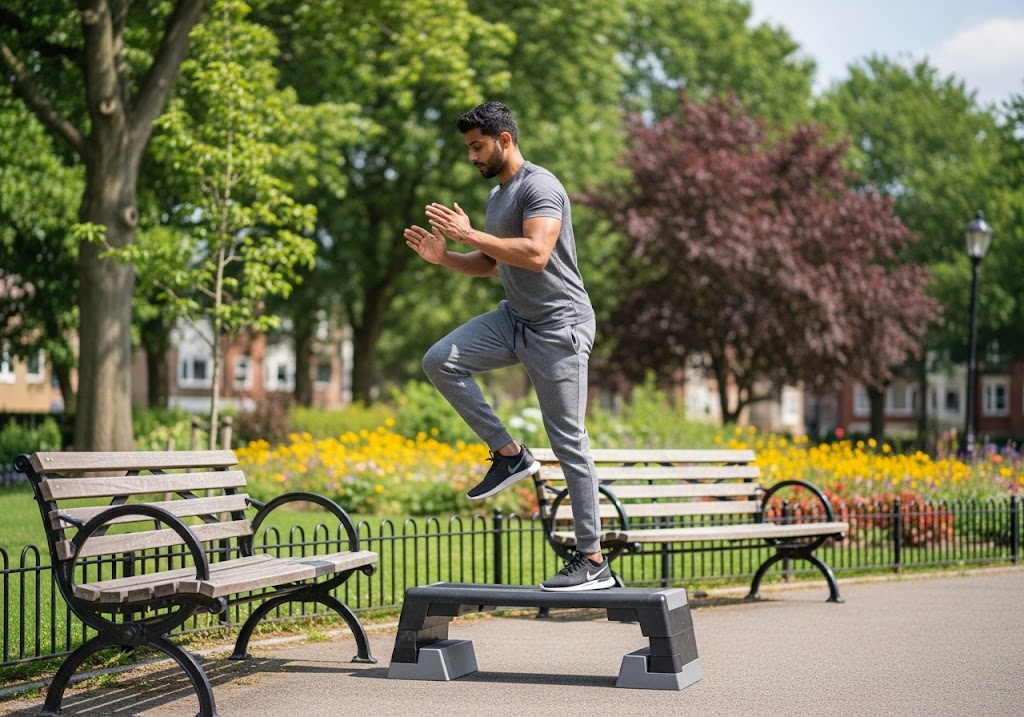
Try this effective Chest and Tricep Workout with Dumbbells for serious strength and definition.
Common Mistakes in Calisthenics Leg Exercises
Avoiding common errors helps you maximize the effectiveness of your calisthenics leg exercises while preventing injury and ensuring optimal muscle development. These mistakes can significantly reduce exercise benefits and lead to poor movement patterns.
- Knee Valgus During Squats: Allowing knees to cave inward during squats reduces exercise effectiveness and increases injury risk. Focus on keeping knees aligned with toes throughout the entire movement range.
- Incomplete Range of Motion: Performing partial repetitions limits muscle development and joint mobility benefits. Always move through full range of motion unless physical limitations prevent proper form.
- Forward Lean in Lunges: Leaning too far forward during lunges places excessive stress on the front knee and reduces glute activation. Maintain upright torso throughout the movement.
- Rushing Through Repetitions: Moving too quickly through calisthenics leg exercises reduces muscle tension and time under tension. Control both the lowering and lifting phases of each movement.
- Neglecting Single-Leg Training: Focusing only on bilateral movements can create muscle imbalances and limit functional strength development. Include unilateral exercises in your routine.
- Poor Landing Mechanics: Landing heavily during jumping exercises increases impact stress on joints. Focus on soft, controlled landings with bent knees to absorb impact.
Advanced Calisthenics Leg Exercises Progressions
As you master basic movements, progressing to advanced calisthenics leg exercises challenges your strength, balance, and coordination while continuing to build lower body power. These challenging variations require excellent form and conditioning foundation.
- Single-Leg Squats (Pistol Squats) Progress from assisted versions using a chair or wall for support to full unassisted single-leg squats. This advanced movement requires exceptional strength, balance, and ankle mobility.
- Jump Squats with Rotation Add rotational elements to jump squats by turning 180 degrees during the jump phase. This advanced variation improves power, coordination, and spatial awareness.
- Bulgarian Split Squats Elevate your rear foot on a bench or chair while performing lunges. This challenging variation increases range of motion and places greater demands on the working leg.
- Single-Leg Glute Bridges Perform glute bridges with one leg extended, challenging your glutes and hamstrings while improving unilateral strength and stability.
For those interested in comparing training methods, understanding crossfit vs calisthenics can help you choose the best approach for your leg training goals.
Calisthenics Leg Workout Programming
Creating effective calisthenics leg workout programs requires strategic exercise selection, proper progression, and adequate recovery planning. These programming principles ensure consistent progress while preventing overtraining and injury.
- Beginner Program Structure Start with 2-3 leg training sessions per week, focusing on basic movements like squats, lunges, and calf raises. Perform 2-3 sets of 8-15 repetitions, emphasizing proper form over intensity.
- Intermediate Program Structure Progress to 3-4 sessions weekly, incorporating unilateral exercises and isometric holds. Increase volume to 3-4 sets of 10-20 repetitions while adding challenging variations.
- Advanced Program Structure Train 4-5 times per week with complex movements, plyometric exercises, and single-leg variations. Focus on quality over quantity with 3-5 sets of varying repetition ranges.
- Recovery and Progression Allow 48-72 hours between intense leg training sessions, gradually increase difficulty through additional repetitions, sets, or more challenging exercise variations.
Many fitness enthusiasts wonder does calisthenics build muscle effectively? Calisthenics leg exercises provide excellent muscle-building stimulus through progressive overload and varied movement patterns.
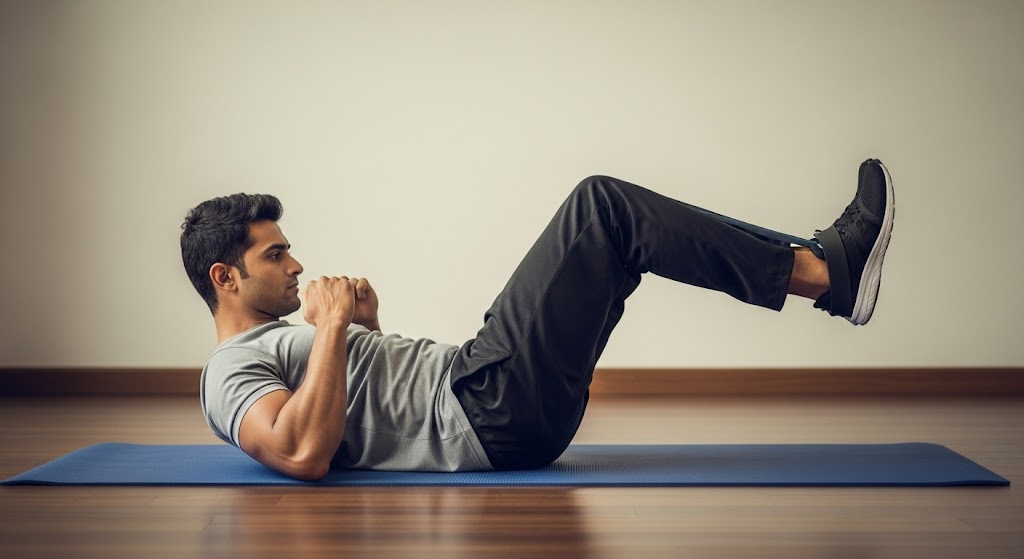
Safety Tips for Calisthenics Leg Exercises
Practicing calisthenics leg exercises safely requires proper preparation, technique awareness, and listening to your body signals. These essential safety guidelines help prevent injury while maximizing training effectiveness and long-term progress.
- Proper Warm-Up Protocol: Always begin with 5-10 minutes of light cardio and dynamic stretching to prepare your muscles and joints for intense leg training sessions.
- Master Basic Movements First: Focus on perfecting fundamental exercises before progressing to advanced variations. Solid technique foundation prevents injury and ensures optimal muscle development.
- Progress Gradually: Increase exercise difficulty slowly over time rather than jumping to advanced movements too quickly. This approach allows your body to adapt safely to increasing demands.
- Listen to Your Body: Stop immediately if you experience pain, unusual discomfort, or excessive fatigue during exercises. Rest and recovery are essential components of effective training.
- Maintain Proper Hydration: Drink adequate water before, during, and after training sessions to support muscle function and prevent dehydration-related performance decline.
- Use Proper Footwear: Wear supportive athletic shoes that provide stability and cushioning during dynamic movements and jumping exercises.
Understanding how to start calisthenics provides valuable guidance for safely beginning your leg training journey with proper progression and technique focus.
Integrating Calisthenics Leg Exercises with Other Training
Combining calisthenics leg exercises with other training modalities creates comprehensive fitness programs that address all aspects of physical development. This integrated approach maximizes results while preventing training plateaus and maintaining motivation.
- Upper Body Integration Combine leg exercises with calisthenics pull workout and back calisthenics for full-body training sessions that improve overall strength and coordination.
- Core Training Combination Integrate leg exercises with core movements to create functional training patterns that improve stability and power transfer throughout your body.
- Cardiovascular Integration Use leg exercises in circuit training formats to combine strength building with cardiovascular conditioning for efficient, time-effective workouts. Learning how to do jumping jacks can complement your leg training with effective cardio intervals.
- Flexibility and Mobility Include stretching and mobility work between leg exercises to maintain joint health and prevent muscle tightness that can limit performance.
For specialized upper body development, explore calisthenics for triceps and forearm calisthenics to build comprehensive strength.
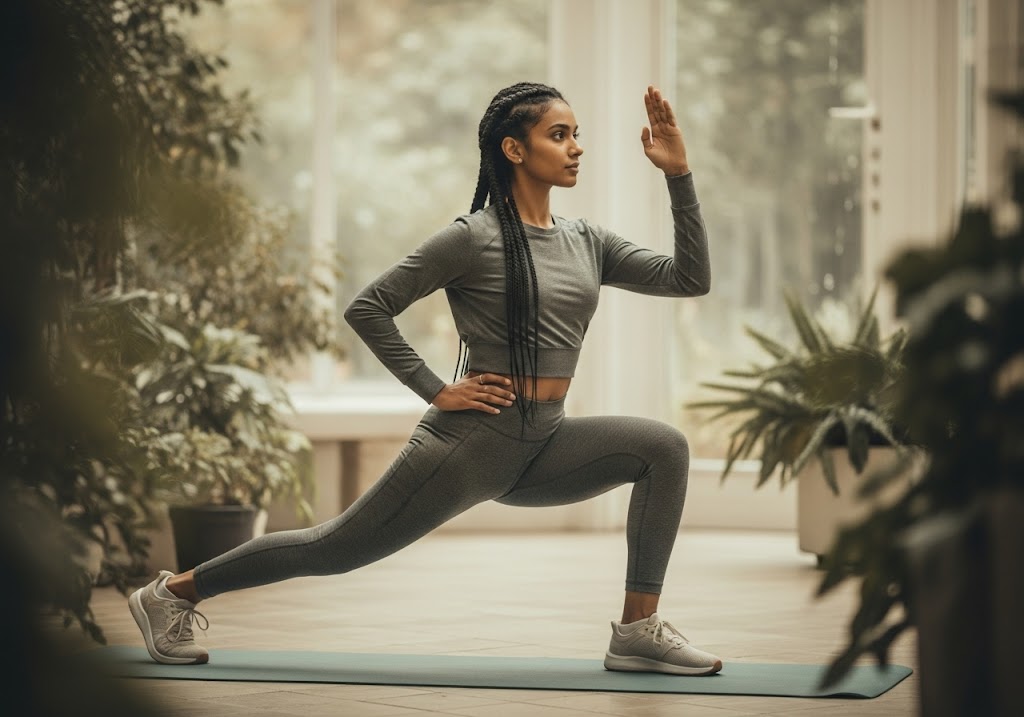
Nutrition and Recovery for Leg Training
Supporting your calisthenics leg exercises with proper nutrition and recovery strategies optimizes training adaptations and prevents overtraining. These lifestyle factors significantly impact your ability to progress and maintain consistent performance.
- Pre-Training Nutrition Consume easily digestible carbohydrates and moderate protein 1-2 hours before training to provide energy for intense leg exercises while supporting muscle function.
- Post-Training Recovery Eat protein and carbohydrates within 30-60 minutes after training to support muscle repair and glycogen replenishment for optimal recovery.
- Hydration Strategy Maintain proper hydration throughout the day, increasing fluid intake during and after training sessions to support muscle function and recovery processes.
- Sleep Quality Prioritize 7-9 hours of quality sleep to support hormone production, muscle recovery, and performance improvements from your leg training sessions.
For weight management alongside leg training, consider incorporating these exercises into calisthenics for weight loss programs for comprehensive fitness results.
Training Environment and Setup
Creating an optimal environment for calisthenics leg exercises enhances safety, motivation, and training effectiveness. These setup considerations help you maximize your bodyweight leg exercises regardless of training location.
- Space Requirements Ensure adequate space for movement in all directions, allowing for lunges, jumps, and lateral movements without obstacles or hazards.
- Surface Considerations Choose appropriate surfaces that provide stability and cushioning for jumping exercises while maintaining traction for safety during dynamic movements.
- Equipment Additions While calisthenics leg exercises require no equipment, items like resistance bands, elevated surfaces, or stability balls can add variety and progression options.
- Training Consistency Establish consistent training times and locations to build sustainable habits that support long-term progress and fitness development.
Understanding calisthenics at home no equipment principles helps you create effective training environments anywhere.
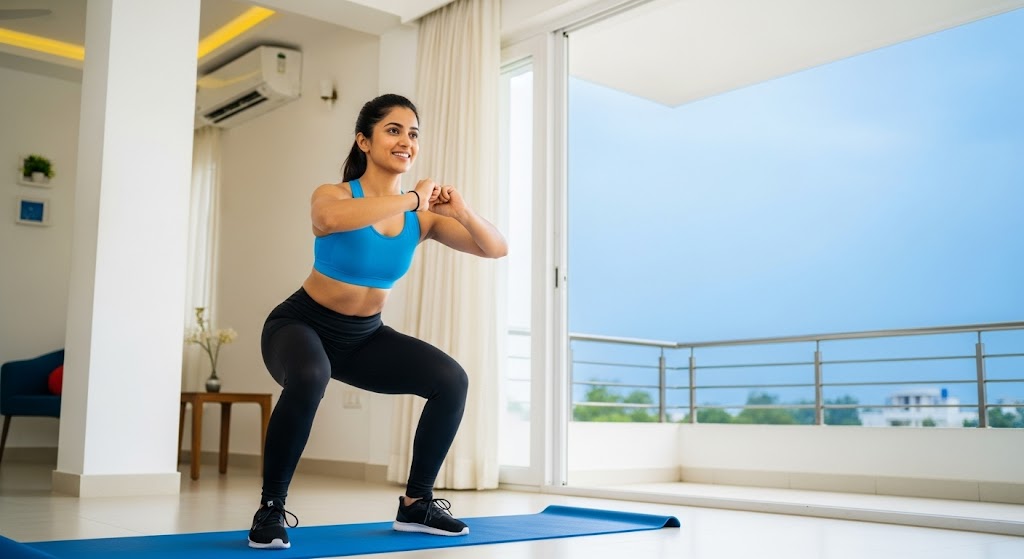
Tracking Progress in Leg Training
Monitoring your progress in calisthenics leg exercises helps maintain motivation while ensuring continuous improvement toward your fitness goals. These tracking methods provide valuable feedback for program adjustments and celebrating achievements.
- Repetition Tracking Record the number of repetitions performed for each exercise, aiming to gradually increase volume over time while maintaining proper form and technique.
- Time-Based Measurements Track how long you can hold isometric exercises like wall sits or single-leg stands, working to increase duration progressively.
- Skill Progression Document your ability to perform advanced movements like single-leg squats, noting improvements in balance, strength, and range of motion.
- Subjective Assessments Monitor how you feel during and after training sessions, noting improvements in energy levels, recovery time, and overall leg strength.
For those interested in comparing training approaches, understanding calisthenics vs gymnastics can help you choose the best methodology for your goals.
Advanced Training Techniques
Once you’ve mastered basic calisthenics leg exercises, advanced training techniques can accelerate progress and break through plateaus. These methods challenge your muscles in new ways while maintaining the bodyweight training philosophy.
- Tempo Manipulation Vary the speed of your movements, using slow eccentrics or explosive concentrics to create different training stimuli and muscle adaptations.
- Isometric Holds Add pauses at challenging positions during exercises to increase time under tension and build strength at specific joint angles.
- Plyometric Progressions Incorporate jumping and bounding movements to develop power and athletic performance while maintaining strength gains.
- Unilateral Emphasis Focus on single-limb exercises to address imbalances and build functional strength that transfers to daily activities and sports.
Advanced practitioners might explore complex movements like calisthenics planche after building solid lower body strength foundation.
Conclusion
Calisthenics leg exercises offer a comprehensive approach to lower body development that’s accessible, effective, and sustainable. The progressive nature of these exercises allows practitioners of all levels to continuously challenge themselves and achieve impressive results. Whether you’re just starting or looking to advance your training, calisthenics provides the perfect platform for building strong, functional legs through natural movement patterns.
If you’re serious about mastering Calisthenics Leg Exercises and want expert support to improve your technique, strength, and recovery, connect with the professionals at ISC – Indian School of Calisthenics. Their certified coaches offer personalized training programs tailored to your fitness level, whether you’re a beginner or looking to break through plateaus. For one-on-one coaching, group sessions, or detailed progression plans, visit them at ISC – Indian School of Calisthenics, SRPF Ground, NH8, Goregaon (E), Mumbai – 400065 or call +91 77159 53218.
Calisthenics Leg Exercises – FAQs
How often should I incorporate calisthenics leg exercises into my routine?
Aim to perform calisthenics leg exercises 2-3 times a week, allowing for 48-72 hours of recovery between sessions.
Is it possible to build significant leg muscle using only calisthenics leg exercises?
Absolutely! Calisthenics leg exercises can effectively increase muscle mass through progressive overload and proper technique.
How long does it typically take to master a pistol squat?
With consistent calisthenics workout practice, most individuals can achieve their first pistol squat within 3-6 months of focused training.
Should I incorporate weight training along with calisthenics leg exercises?
While it’s not necessary, combining both methods can be beneficial. It’s best to first master bodyweight movements and later calisthenics workout.
What is the most effective way to progress with leg calisthenics?
Begin with foundational movements, ensure perfect form, gradually increase volume, then complexity, and finally, incorporate intensity through advanced variations.
How can I prevent knee pain while performing calisthenics leg exercises?
Prioritize proper form, progress gradually, maintain good mobility, and always listen to your body’s signals.
Can you build legs with calisthenics?
Yes, calisthenics can build strong, muscular legs with bodyweight exercises.
How to do an L-sit?
Lift your legs and hips off the floor with arms straight and legs extended forward.
Is 7 exercises too much for leg day?
No, as long as volume and recovery are managed properly.
Is leg curl a push or pull exercise?
Leg curl is a pull exercise that targets the hamstrings.
